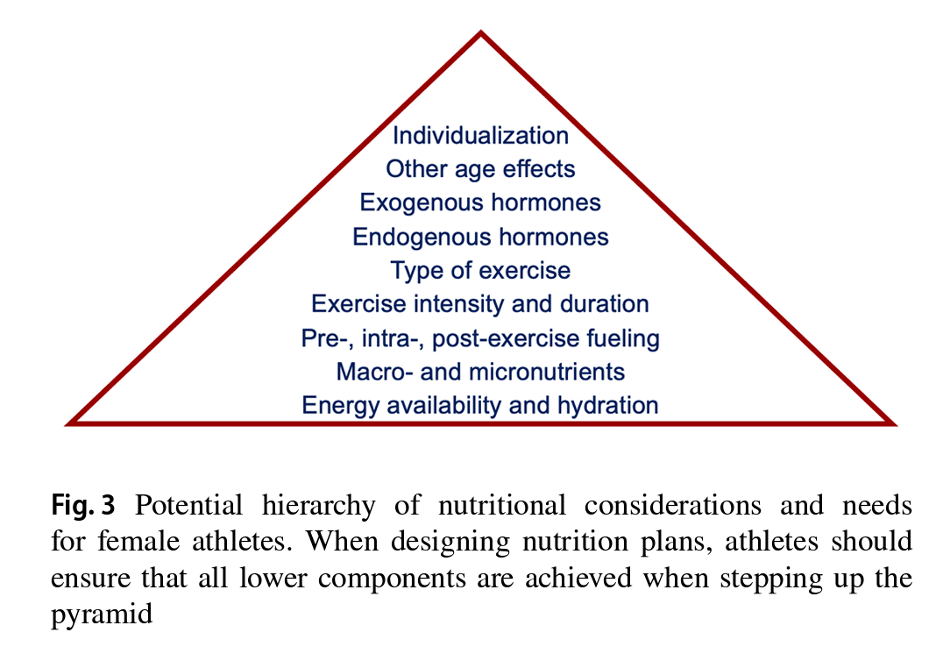
New Insights on Energy Availability for Female Athletes
By Jason Koop,
Head Coach of CTS Ultrarunning
It seems like for the last several years, female athletes have been told to tailor their training, nutrition and even the way they recover towards their menstrual cycle. Apps like Wild AI and books like ROAR have done quite well in the commercial space, leading to specialty off-shoots like these continuing education courses, which I and several of our coaches have taken. While I’ve learned a lot about how ‘Women are not Small Men’ (and yes, I will even rock this shirt), from each of these iterations of the same theme; women are underrepresented in sports science research. Indeed, in the years 2011, 2012 and 2013 only 4% of studies in three of the most prestigious sports medicine journals were female only. Those same years, women represented only 39% of all study participants despite comprising nearly half of the participants in all sports (Brookshire 2016, Costello 2014). This led to an assumption by some (me included) that we might be misapplying sports science derived from men to women. The aforementioned interventions around training, nutrition and recovery then took root into our collective psyches.
A new review and commentary published in the journal Sports Medicine this year got me thinking about this topic again. Particularly when coaches begin applying training interventions based on current trends, we should always go back to the fundamentals first. In this case, before you decide to change something like your strength training based on your menstrual cycle, let’s make sure that the fundamentals are covered first. In this case, that’s energy availability.
Why energy availably matters
Energy availability is represented by the amount of energy you consume minus the amount of energy you expend during exercise, normalized to your fat free mass. In other words, how many calories have you consumed above and beyond what it takes to cover your caloric needs from training. It is a representation of the energy you have available to rebuild muscle tissue, thermoregulate and maintain normal physiological function. While this number is important to know, it is difficult to calculate outside of a laboratory setting. Despite these calculation calamites, a considerable amount of research has been performed to determine what levels of energy availability will best support training adaptions. Energy availability below a certain level puts the athlete is at risk for Low Energy Availability, which can result in several negative consequences (more on that later).
The consensus is that female athletes should shoot for energy availability of ~45 kcal/kg of fat free mass (fat free mass is just everything in your body that’s not fat). Put your hard hats on for some simple math and let’s put that into some context with a theoretical athlete. A 60 kg female athlete with 22% body fat will have 46.8 kg of fat free mass (60kg X (100%-22%)). This athlete will need to target an energy availability intake of 2,106 calories (45 calories X 46.8 kg). Remember, energy availability is the amount of energy you need above and beyond what is required for training. So, if this athlete goes out on a 10-kilometer training run, requiring 600 calories (using an assumption that the energy cost of running is 1kcal/kg/km), her total energy intake for the day should be 2,700 calories to support training and the host of recovery and physiological responses.
I point out the simple math lesson in this vein: it’s a lot of calories. Likely more than most people think. But the research is compelling in this area. Low energy availability has the potential to cause menstrual cycle disturbances, bone health issues, deficiencies in iron, calcium, and other micronutrients; and to compromise the immune system. Energy availability, the raw number of calories you take in beyond what is required for exercise, is fundamental and should be the supporting base of your nutritional pyramid. The authors of the review paper propose this hierarchy of needs to illustrate the point:
Enjoying This Article? Get More Free Running Training Tips
Get our coaches' best training advice, delivered straight to your inbox weekly.
Source: Holtzman and Ackerman 2021
Simple, but not easy
“But we can do both. We can get energy availability right and leverage training that is suited towards specific aspects of our female physiology.” Most of the time, I would agree with a statement like this. Athletes should be able to walk and chew bubblegum at the same time. They should be able to get the fundamentals right, and then add on advanced training interventions. However, in this case, the data indicates that all too often, female athletes are at risk for low energy availability. A survey in 2019 of over 1000 female athletes revealed that nearly half of female athletes ages 15-30 years were at risk of low energy availability (Ackerman 2019). So, if only half were getting the fundamental aspect of energy availably right, why then are we seemingly focused on introducing interventions based around menstrual cycle and other aspects of female physiology, which are vastly more complicated and result in markedly inferior adaptations?
Fundamentals first, terrain traps second, complicated stuff last
Here’s my plea for female athletes and the coaches working with them: Make sure you get the fundamentals of energy availability right first. If you are serious about your nutrition and want to better leverage it in your training, take some time and work with a qualified Registered Dietician and get the basics right. This means tracking calories in and out, which is not so simple of a chore. Once you’ve gotten a handle on the addition and subtraction of energy availability, then you can focus on individual aspects of your physiology. The simplest and most effective way is to simply track the days of your menstrual cycle, note which days you feel like crap (if any) and try to avoid hard workouts on those days (and don’t stress if can’t avoid it).
Rearranging your hard and/or long run days on the days you are going to perform optimally is an easy and effective way to leverage your specific physiology. Finally, once (or if) you’ve mastered these first two steps, you can think about advanced interventions like rearranging your strength training or introducing different recovery modalities around your menstrual cycle. While the evidence supporting these interventions is thin, so is the overall research landscape in this area. And as the saying goes, “the absence of evidence is not evidence of absence.”
References-
- Ackerman KE, Holtzman B, Cooper KM, Flynn EF, Bruinvels G, Tenforde AS, et al. Low energy availability surrogates correlate with health and performance consequences of relative energy deficiency in Br J Sports Med. 2019;53(10):628–33.
- Brookshire B. Women in sports are often underrepresented in science. 2016. https://www. sciencenews.org/blog/scicurious/women-sports-are-often-underrepresented-science
- Costello JT, Bieuzen F, Bleakley CM. Where are all the female participants in sports and exercise medicine research? Eur J Sport 2014;14(8):847–51.
- Holtzman, B., Ackerman, K.E. Recommendations and Nutritional Considerations for Female Athletes: Health and Performance. Sports Med(2021). https://doi.org/10.1007/s40279-021-01508-8


Comments 1
Thanks for tackling this issue, Koop! We need more science, more dialogue and more awareness of how women have different nutritional and training needs and responses; this helps.